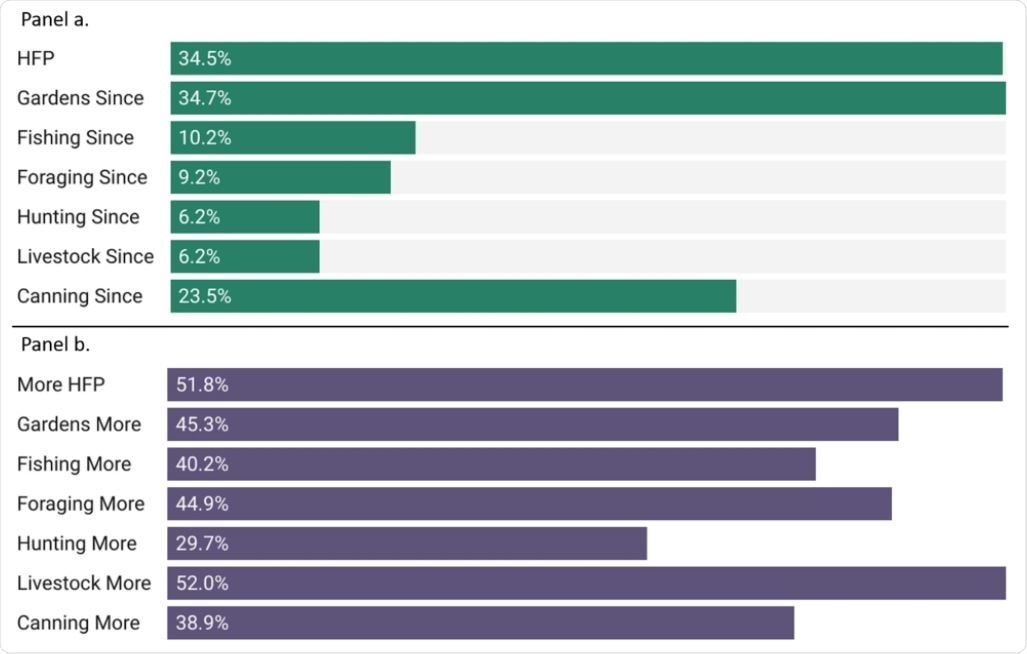Home food procurement (HFP), including fishing, gardening, hunting, foraging, backyard livestock, and canning, have been important ways for people to obtain food historically. Research shows that some HFP activities such as gardening have recently increased, while others such as hunting have decreased in the US.
The COVID-19 pandemic has led to an increase in HFP activities, as shown by the increase in hunting licenses and seed and canning supply shortages. While it is known that HFP activities may have a positive impact on diet quality and food security, research focusing on activities other than gardening is limited in high-income countries.
Analyzing how engagement in HFP activities have changed during the COVID-19 pandemic
Recently, researchers from the US examined changes in patterns of HFP activities since the beginning of the COVID-19 pandemic and their relationship to dietary quality and food security. They used multivariable logit models and matching analysis along with a state-wide representative survey among 600 residents of Vermont, US. This study is published in the BMC Public Health journal.
Data for the study were collected with the help of a survey developed in collaboration with researchers from the National Food Access and COVID research Team. In addition to individual and household sociodemographics, the survey assessed several components of food security, food access, HFP, dietary intake, the impact of COVID-19, and participation in food assistance programs.
“We use one-way analysis of variance (ANOVA) to examine diet quality intake at the time of the survey as it relates to HFP, specific HFP activities, and intensity of HFP.”

a Percent of respondents engaging in any HFP, and specific HFP activities since COVID-19. Percentages include all respondents (n = 600). b Among respondents who engaged in any HFP (n = 205), percent of those that increased intensity or did a new HFP activity since COVID-19
Results show that vulnerable, food-insecure populations are more likely to engage in increased HFP during COVID-19
The study results showed that 29% of respondent households can be classified as ‘food insecure’ since the beginning of the pandemic. Additionally, the study revealed a higher prevalence of food insecurity in populations earning less than $50,000 per year, those experiencing negative job changes due to COVID-19, and Hispanic and multi-racial respondents.
About 35% of respondents were engaged in HFP activities since the pandemic began; most of those were involved in gardening, and over half of those were either more involved in HFP activities than before the pandemic or started HFP activities for the first time during the pandemic.
Households experiencing food insecurity were more likely to pursue HFP activities - such as gardening, foraging, fishing, and hunting – more intensely. Those who were food insecure, Indigenous and Black people, People of Color, larger households, and those with a job disruption all were shown to be more likely to engage in increased HFP during the pandemic. Interestingly, HFP was significantly associated with increased consumption of fruits and vegetables, although this was only significant for households that were food secure.
“The results demonstrate that HFP activities significantly increased during the first five months of the COVID-19 pandemic and were especially prominent among food-insecure households.”
Increased interest and intensity of HFP reveals the need for educational and outreach efforts
In summary, these findings indicate that HFP activities have increased since the beginning of the pandemic, and they may be an important safety net for households experiencing food insecurity. However, the findings also showed that, for food-insecure households, HFP does not translate into the level of increased fruit and vegetable intake found in HFP households that were food secure.
This suggests that households with food insecurity may be trying to maintain food intake or might need help with resources or technical assistance. In the long term, HFP activities may have a significant impact on food security and diet quality. According to the authors. HFP may also have implications on conservation and more studies need to explore this effect of HFPs. Nevertheless, the increase in interest and intensity of HFP activities reveals important opportunities for education as well as outreach efforts.
“As well, additional collaborations within the conservation sector may be important to assess the long-term impact of increased levels of HFP that may affect forests, waterways, and species.”